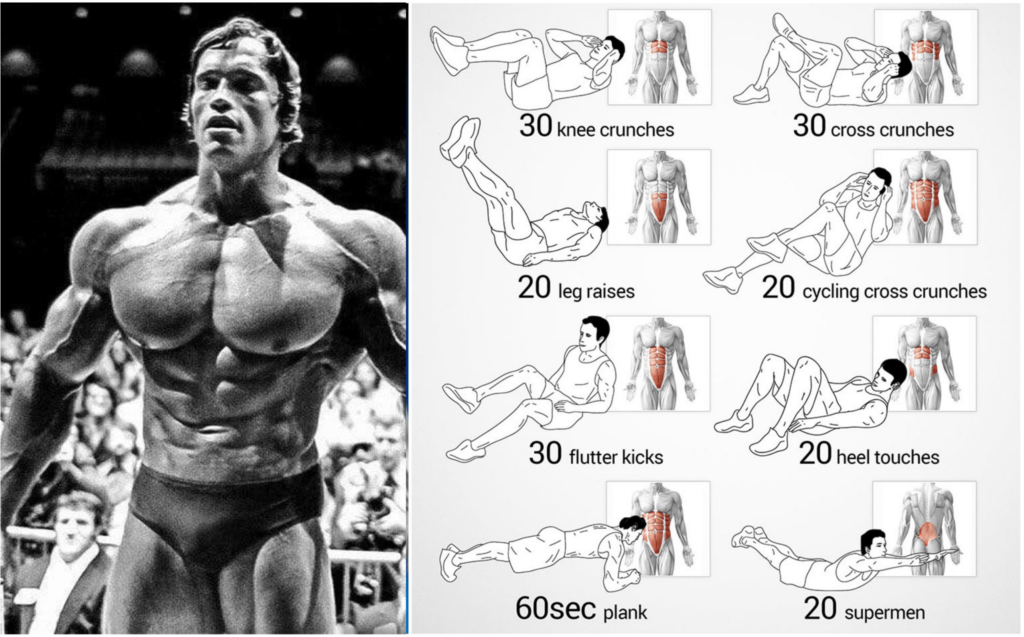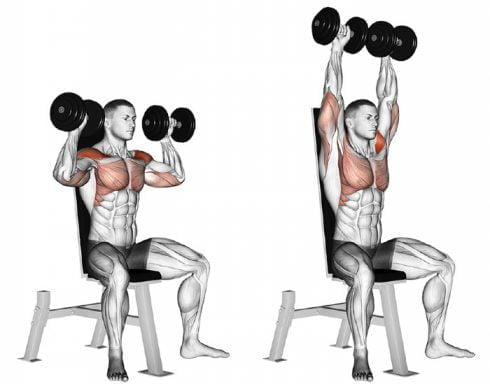Weight training is a critical component of any fitness regimen, offering numerous physical and mental benefits. Building strength and muscle mass can increase your metabolism, improve bone density, and boost overall physical performance. In addition to these benefits, weight training can also help to improve mental well-being, as it releases endorphins that can elevate mood and reduce stress.
However, for those new to weight training, the prospect of lifting weights can be daunting. The weight room can be an intimidating place, filled with advanced equipment and experienced lifters who seem to know exactly what they’re doing. For beginners, it can be difficult to know where to start, what exercises to do, and how much weight to lift.
To help you get started, we’ve compiled a list of weight training tips for beginners. These tips will help you feel confident and comfortable in the weight room and will set you up for success as you progress on your fitness journey. Whether you’re looking to build muscle, increase strength, or simply improve your overall health and well-being, these tips will help you get there. So, let’s dive in and explore what you need to know to get started with weight training.
Weight Training Tips for Beginners
Here we are introducing 17 weight training tips for beginners that will help you to do injury-free workouts.
- Start with light weights: As a beginner, it is important to focus on proper form and technique rather than lifting heavy weights. Starting with lighter weights helps you get a feel for the movement and build up strength gradually, reducing the risk of injury.
- Incorporate compound exercises: Compound exercises are movements that work for multiple muscle groups at the same time, such as squats, deadlifts, bench presses, and rows. Incorporating these exercises into your routine can help you build full-body strength and improve functional movements.
- Gradually increase weight and volume: Once you have built up a good foundation of strength and proper form, you can gradually increase the weight you lift and the volume of your workout. Overdoing it too soon can lead to overtraining and injury.
- Focus on proper form: Proper form is critical to prevent injury and ensure you are targeting the correct muscle groups. If you are unsure about the correct form for a particular exercise, it is always a good idea to ask a trainer for assistance.
- Vary your routine: Mixing up your exercises, sets, reps, and weight can help prevent boredom and target different muscle groups. Changing your routine regularly can also help you avoid plateaus and continue making progress.
- Stay hydrated and eat well: Proper nutrition and hydration are essential for muscle growth and recovery. Aim to drink plenty of water and consume a balanced diet with enough protein to support your weight training goals.
- Rest and recover: Allowing time for your muscles to recover between workouts is important. A good guideline is to allow 48 hours between working for the same muscle group. This gives your muscles time to repair and grow.
- Find a workout buddy: Having someone to train with can provide motivation, accountability, and help with proper form. Training with a partner can also make your workout more enjoyable and provide a support system to help you reach your goals.
- Warm up properly: Always start with a 5-10 minute warm-up to raise your heart rate and loosen up your muscles. This can include dynamic stretching, cardio, or foam rolling.
- Focus on progressive overload: To continue making progress, aim to gradually increase the weight you lift, reps or sets over time.
- Balance your workout: Incorporate a mix of push, pull, and leg exercises for a balanced workout.
- Track your progress: Keeping track of your weight lifted, sets, and reps can help you measure progress and set achievable goals.
- Get enough sleep: Getting enough sleep is important for recovery and muscle growth. Aim for 7-9 hours of sleep per night.
- Stretch after your workout: Stretching after your workout can help reduce muscle soreness and improve flexibility.
- Listen to your body: If you feel pain or discomfort, stop the exercise and rest. Don’t push through pain, as this could result in injury.
- Consider hiring a personal trainer: Hiring a personal trainer can provide personalized workout plans and help you reach your goals faster.
- Mix it up: Including a mix of weight training and cardio exercises can help improve overall fitness, and increase muscle endurance and cardiovascular health.
Essential Equipment for Starting a Weight Training Program
To start weight training, you will need the following:
- A gym membership or home gym equipment: Access to weights and weight training equipment is necessary, this can be in the form of a gym membership or purchasing equipment for a home gym.
- Proper attire: Comfortable clothing and supportive shoes are essential for weight training. Avoid loose clothing that can get caught in equipment.
- Water bottle: Staying hydrated is important during and after weight training, so bring a water bottle to stay hydrated.
- Music or headphones: Listening to music or audio can help improve motivation and make weight training more enjoyable.
- Weightlifting gloves or grip pads: These can help improve grip and reduce the risk of blisters.
- Resistance bands or dumbbells: To start, you may want to purchase a set of resistance bands or dumbbells, depending on your budget and the space available.
- Workout mat: A workout mat can provide comfort and protect your flooring during floor exercises.
- Towel: A towel can be used to wipe sweat and equipment, and to provide cushioning during floor exercises.
- Foam roller: A foam roller can be used for warm-up and cool-down stretching, as well as for self-massage to improve muscle recovery.
- A plan or routine: Having a workout plan or routine can help you stay organized and motivated, and ensure you are working for all the major muscle groups.
Essential Weight Training Exercises for Beginners
You may be particularly interested in developing your biceps or toning your legs, but the best resistance training program targets all of your major muscle groups.
Overworking one muscle group at the expense of another can actually increase your risk of injury.
You might want to start with the following exercises for a good all-around workout. Including these exercises in your weight-lifting routine will work the majority of your body’s large muscle groups.
Dumbbell single-arm rows
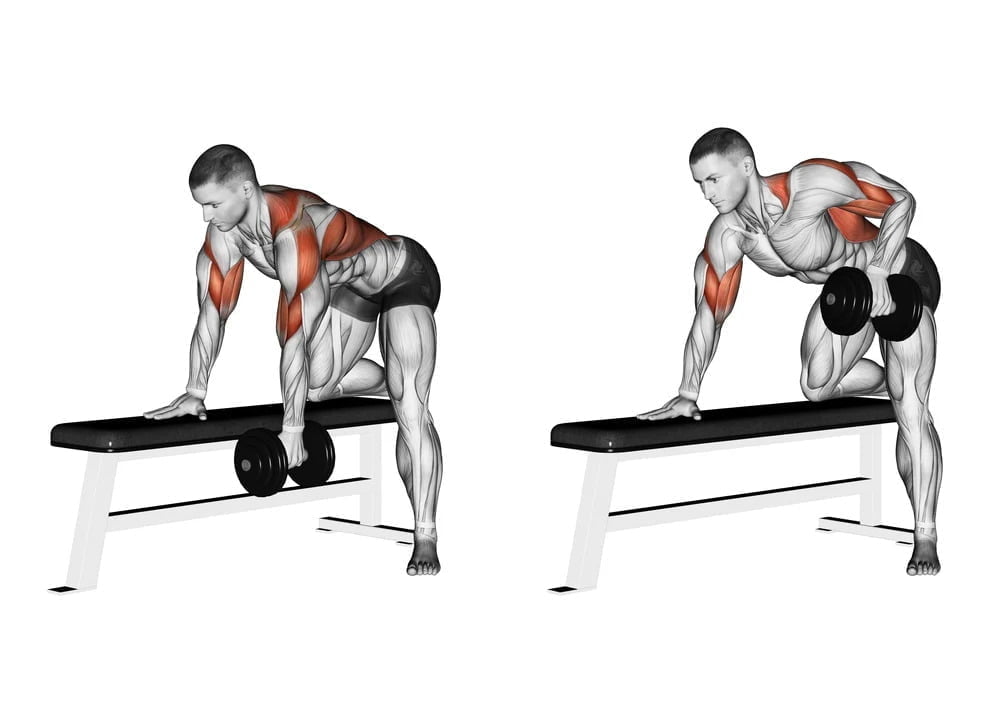
Dumbbell single-arm rows are a weight training exercise that targets the back, biceps, and shoulders.
Steps to follow:
- Stand with feet hip-width apart, holding a dumbbell in one hand.
- Bend forward at the hips, keeping your back straight, until your torso is nearly parallel to the floor.
- Keep your non-working arm on your hip or use it to support your body by placing it on a bench.
- Pull the dumbbell up to your side, keeping your elbow close to your body.
- Lower the dumbbell back to the starting position.
- Repeat the exercise for the desired number of repetitions before switching arms.
Dumbbell shoulder press

The dumbbell shoulder press is a weight-training exercise that targets the shoulders and triceps.
Steps to follow:
- Stand with feet hip-width apart, holding dumbbells at shoulder height with palms facing forward.
- Push the dumbbells up and overhead, fully extending your arms.
- Lower the dumbbells back to the starting position, keeping the elbows slightly bent.
- Repeat the exercise for the desired number of repetitions.
Dumbbell chest press
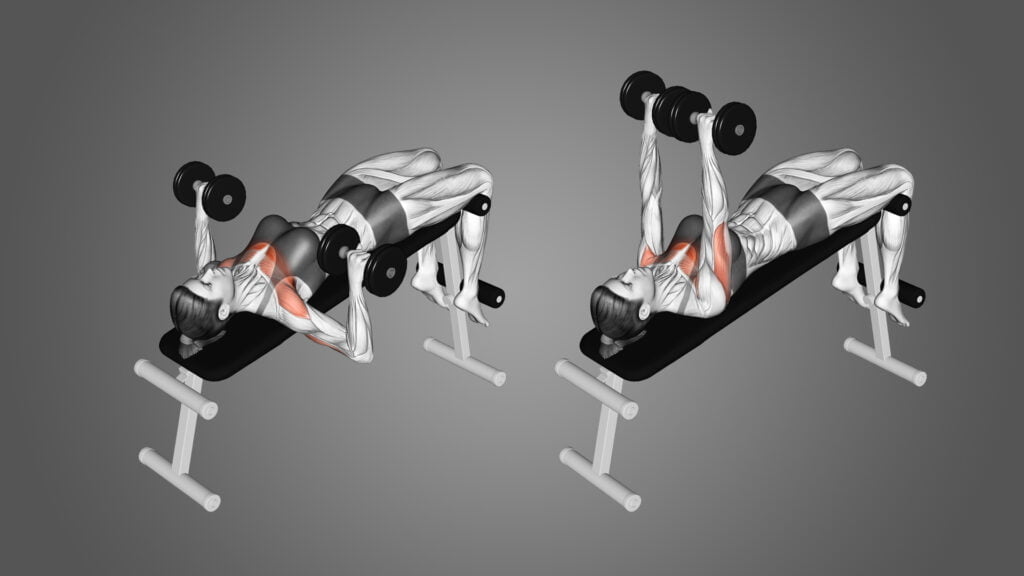
The Dumbbell Chest Press is a weight training exercise that targets the chest, triceps, and shoulders.
Steps to follow:
- Lie on a flat bench with feet firmly planted on the floor.
- Hold a pair of dumbbells above your chest with palms facing forward.
- Lower the dumbbells to the sides of your chest, keeping your elbows at a 90-degree angle.
- Push the dumbbells back up to the starting position.
- Repeat the exercise for the desired number of repetitions.
Bicep curls
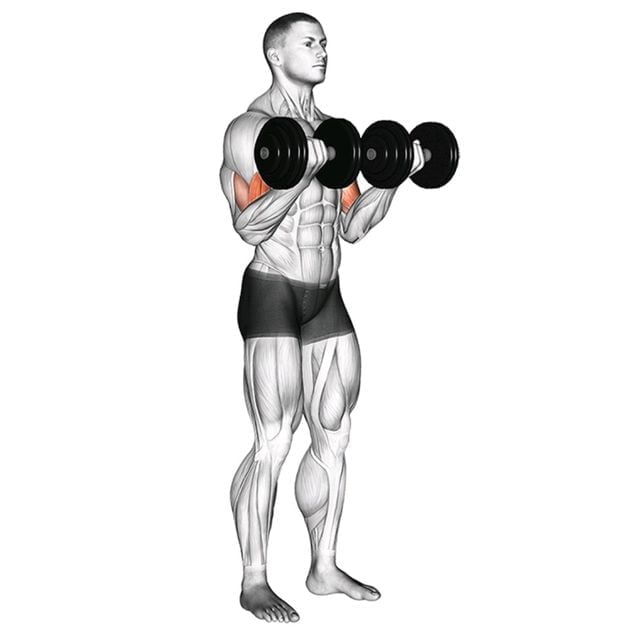
Bicep Curls are a weight training exercise that targets the biceps.
Steps to follow:
- Stand with feet hip-width apart, holding a pair of dumbbells at arm’s length by your sides with palms facing forward.
- Curl the dumbbells towards your shoulders, keeping your elbows close to your body.
- Lower the dumbbells back to the starting position.
- Repeat the exercise for the desired number of repetitions.
Triceps extensions

Tricep extensions are a weight training exercise used to target the tricep muscles. They can be performed with dumbbells, barbells, cable machines or resistance bands.
Steps to follow:
- Start by selecting the appropriate weight for your fitness level.
- Grasp the weight with both hands, using a palms-up grip.
- Hold the weight overhead with straight arms, keeping the upper arms close to your head.
- Lower the weight behind your head by bending your elbows.
- Keep your upper arms stationary and your elbows close to your head throughout the movement.
- Once you feel a stretch in your tricep, extend your arms to lift the weight back to the starting position.
- Repeat for the desired number of repetitions.
Resistance band pull apart
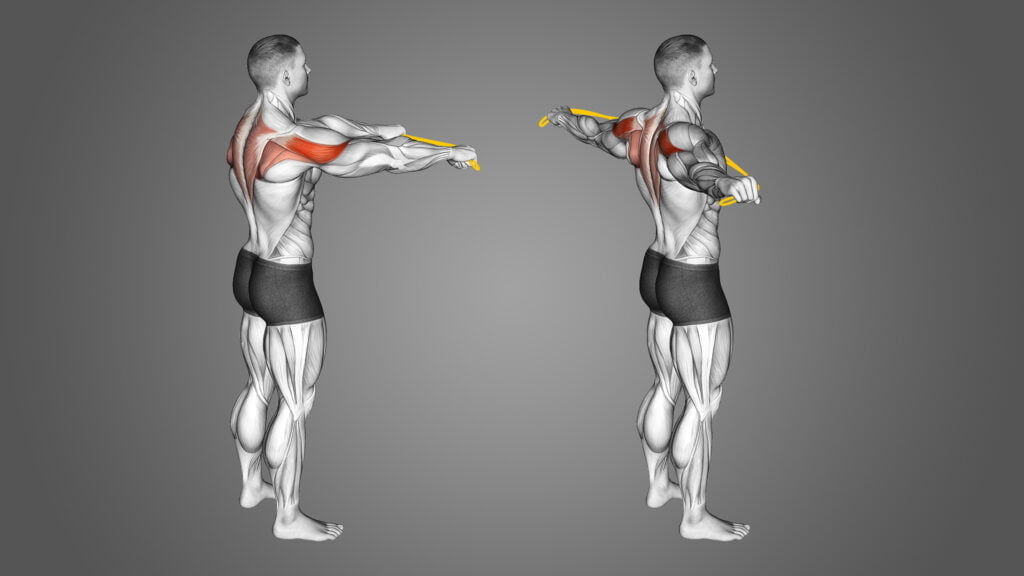
The resistance band pull apart is an exercise that targets the muscles in the upper back, including the shoulders and the upper back. This exercise can be performed with a resistance band or tubing, making it a convenient and portable option for strengthening these muscle groups.
Steps to follow:
- Hold the resistance band or tubing in both hands, with your arms extended straight in front of your body.
- Pull the band apart by bringing your arms out to the sides, keeping your arms straight and your shoulders down.
- Keep your core engaged and your back straight as you pull the band apart.
- Pause briefly when your arms are fully extended, then slowly return to the starting position.
- Repeat for the desired number of repetitions.
Lunge

A lunge is a lower-body strength training exercise that targets the muscles in the legs and hips, including the quadriceps, hamstrings, glutes, and calves.
Steps to follow:
- Stand with your feet hip-width apart, holding your arms at your sides or using weights for added resistance.
- Step forward with one leg, landing with your heel first and bending both knees to lower your body towards the ground.
- Descend until your front knee is bent at a 90-degree angle and your back knee is hovering just above the ground.
- Push through your front heel to straighten your legs and return to the starting position.
- Repeat with the opposite leg, alternating sides with each repetition.
Squats

Squats are a multi-joint strength training exercise that primarily targets the muscles in the legs, including the quadriceps, hamstrings, and glutes. They also engage the core and lower back muscles.
Steps to follow:
- Stand with your feet hip-width apart, holding your arms out in front of your body or with weights.
- Lower your body as if you were sitting back in a chair, keeping your back straight and your core engaged.
- Bend your knees and lower your hips, making sure that your knees do not extend beyond your toes.
- Pause briefly in the lowest position, then straighten your legs to return to the starting position.
- Repeat for the desired number of repetitions.
Calf raises
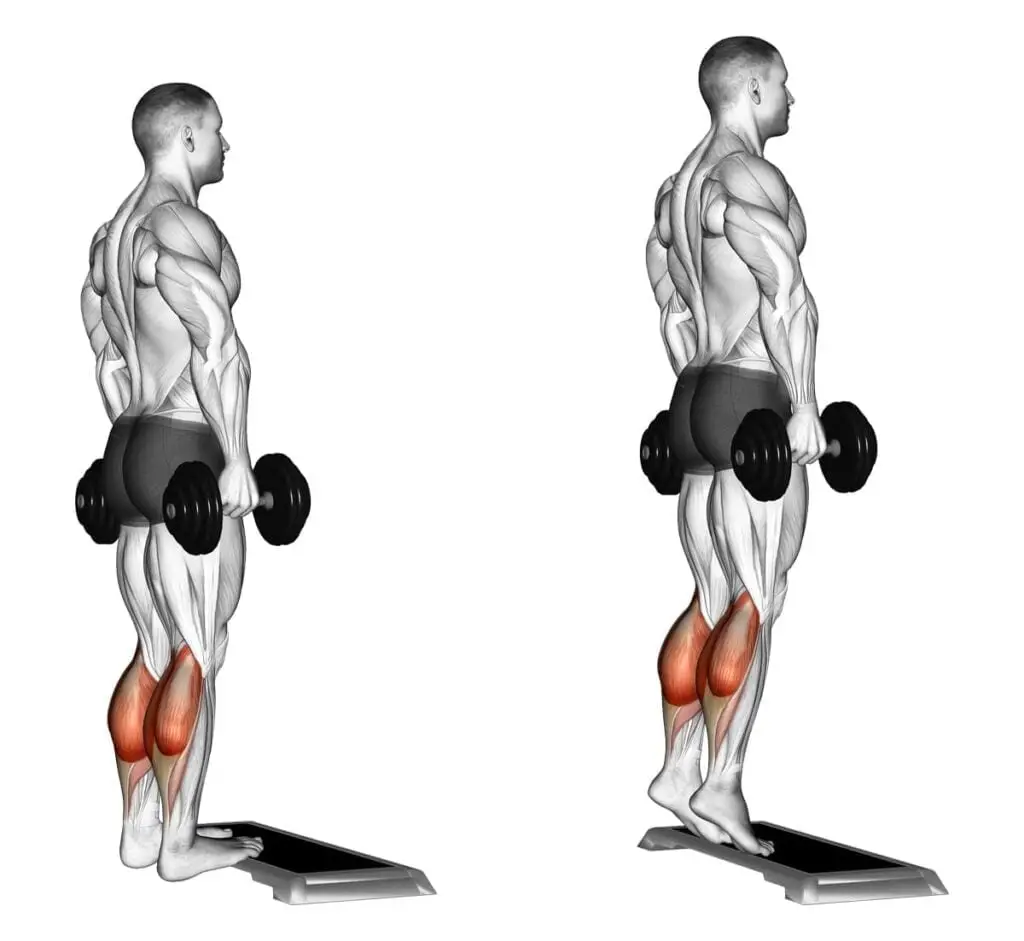
Calf raises are a lower body strength training exercise that targets the muscles in the calves, specifically the gastrocnemius and soleus.
Steps to follow:
- Stand with your feet hip-width apart, with your arms at your sides, or hold weights for added resistance.
- Rise up onto your toes, lifting your heels off the ground as high as you can.
- Pause briefly at the top, then lower your heels back down to the starting position.
- Repeat for the desired number of repetitions.
Plank
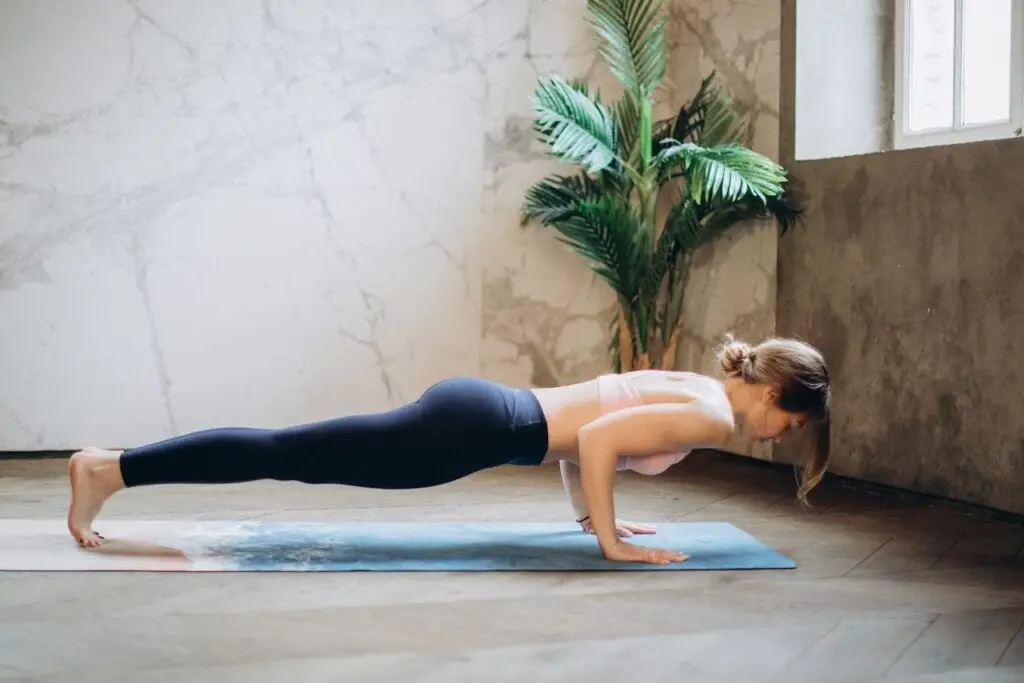
The plank is a bodyweight exercise that targets the muscles in the core, including the abs, obliques, and lower back. It is a static hold exercise that helps to improve stability and strengthen the core.
Steps to follow:
- Start on your hands and knees, with your hands positioned directly under your shoulders.
- Straighten your legs behind you, balancing on your toes and hands.
- Engage your abs and maintain a straight line from your head to your heels, avoiding any sagging or arching in the lower back.
- Hold the position for the desired amount of time, typically 30 seconds to 1 minute or more.
- Lower yourself to the ground and repeat for multiple sets, if desired.
Weight training schedule For Beginners
If your primary goal is to increase strength, three weight-training workouts per week should suffice.
A 2022 study found that doing a weight training routine three times a week is just as effective as doing more frequent workouts for strength building.
However, if you want to gain muscle mass, you’ll need to do more repetitions and work out more frequently.
You can work all of your muscle groups during a workout by beginning with 1 or 2 sets of each exercise and gradually increasing the number of sets or weights as the exercises become easier.
Alternatively, you can target specific muscle groups on specific days. As an example:
Day 1:
- Warm-up: 5-10 minutes of light cardio
- Squats: 3 sets of 8-12 reps
- Dumbbell bicep curls: 3 sets of 8-12 reps
- Dumbbell tricep extensions: 3 sets of 8-12 reps
- Cool-down: 5-10 minutes of stretching
Day 2:
- Warm-up: 5-10 minutes of light cardio
- Dumbbell lunges: 3 sets of 8-12 reps per leg
- Dumbbell chest press: 3 sets of 8-12 reps
- Dumbbell rows: 3 sets of 8-12 reps
- Cool-down: 5-10 minutes of stretching
Day 3:
- Warm-up: 5-10 minutes of light cardio
- Plank: 3 sets, hold for 30-60 seconds
- Dumbbell shoulder press: 3 sets of 8-12 reps
- Dumbbell flys: 3 sets of 8-12 reps
- Cool-down: 5-10 minutes of stretching
It is important to start with lighter weights and gradually increase the resistance as you become stronger. You should also allow for at least 48 hours of rest between weight training sessions to allow the muscles time to recover.
Note: This is just a sample weight training schedule and can be modified based on individual needs and goals. It is recommended to consult with a certified personal trainer or a medical professional before starting any new exercise program.
Safety Tips You Should Follow During Weight Training
When beginning a weight-training regimen, it is critical to prioritize safety. Pay close attention to your body and resist the urge to overdo it.
To stay safe while lifting weights, remember to:
- Wear appropriate weight-lifting clothing, such as closed-toe shoes and, if necessary, weight-lifting gloves.
- Perform each exercise slowly and with proper form.
- Use a spotter to assist you with heavier lifts, particularly those above your head.
- Maintain hydration throughout your workout.
- Inhale before and exhale during your lift. When lifting weights, never hold your breath.
- Stop working out if you experience sharp or stabbing pain. If the pain does not go away after you stop exercising, see a doctor.
If you have a medical condition, consult your doctor about a weight training and exercise program that is appropriate for you.
Conclusion
In conclusion, weight training is a great way to improve your overall fitness and health. For beginners, it is important to focus on proper form and engage the correct muscle groups. Some weight training tips for beginners include starting with lighter weights, gradually increasing the resistance, incorporating a variety of exercises, allowing for adequate rest and recovery, and consulting with a certified personal trainer or medical professional before starting any new exercise program. By following these guidelines and tips, weight training can be a safe and effective way for beginners to reach their fitness goals.

Good day, and welcome to Fitthour. My name is Shubham Vijay, and I am a certified personal trainer and nutrition coach with 6 years of experience in the fitness industry. At Fitthour, we specialize in types of training, such as strength training, cardio, or HIIT, and our mission is to help clients achieve their fitness goals and improve their overall health.

